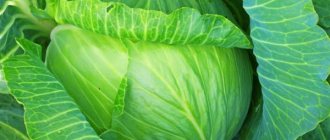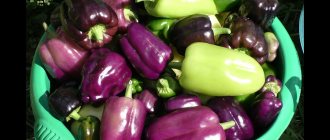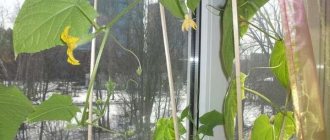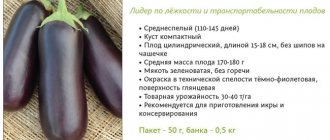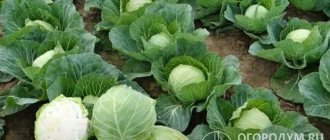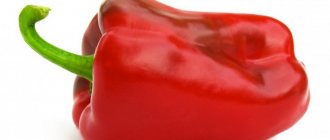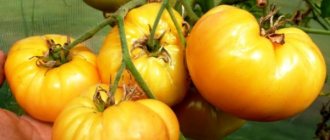White cabbage Dominant F1 is a high-yielding hybrid with a late ripening period. Late ripening is one of the few shortcomings. The heads of cabbage are perfectly stored, suitable for preparation and fermentation, and have a good taste.
| Landing location | Ripening time | View | Purpose | Origin | Maturation period | Weight |
| Open ground | Late ripening | White cabbage | Fresh, Long-term storage, Pickling, Cooking, Processing | Hybrid | 160-170 | 2-6 |
History of selection
The white cabbage variety Dominant F1 is a first generation hybrid, as evidenced by the letters F1 in the designation.
The originator of the variety is the Moscow “Breeding Station named after N. N. Timofeev.” at the Timiryazev Academy, authored by Monakhos G.F. The hybrid was included in the State Register of the Russian Federation in 2011 and approved for cultivation in the North-Western and Central regions, the Volga and Far Eastern regions. It cannot be grown in the north, because the growing season lasts up to six months, but in the southern and central regions it shows good heat-resistant properties. Did you know? The Timiryazev Academy, which is a leader in the selection of cabbage crops in the Russian Federation, stores the gene pool of Russian cabbage.
Description and characteristics
Variety Dominant F1 is a late-ripening variety of white cabbage, which is recommended for private cultivation and commercial production, for fresh use, pickling and winter storage. The full ripening period is 160–170 days from sowing the seeds to harvesting.
Appearance of cabbage
The bush is large in size with abundant leaf mass. The rosette is raised, sits on a high stem - the outer stalk. The rosette leaves are blue-green with an intense natural waxy coating, large, spreading, wavy at the edges. The root system is tap-type, located along the surface and up to 40 cm deep.
Properties of heads of cabbage
The outer leaves covering the head of cabbage are blue-green. The head of cabbage itself is round and dense, white or slightly creamy when cut, the length of the inner stalk is average. Weight 2–4 kg. The taste is good. 100 g of product contains:
- dry matter - 8 g;
- sugar components - 5 g;
- vitamin C - 30 mg.
Thanks to their high density (4.5 points out of 5), the heads of cabbage do not crack even with a lack of irrigation and are well preserved.
Did you know? Charles Darwin argued that all varieties of cabbage originated from one, still unidentified, wild species. But the abundance of varieties and varieties - over 150 - speaks of the amazing properties of cabbage for the formation of new varieties.
Frost resistance and productivity
The degree of frost resistance of cabbage depends on the age - seedlings or adult plants. Seedlings are less frost-resistant and will suffer from frost on the ground. But hardening at low temperatures in the early stages of development and the correct use of phosphorus-potassium fertilizers can significantly increase these indicators. Young seedlings will tolerate short-term frosts down to -3°C, grown ones - up to -5°C. Adult late cabbage is more frost-resistant and will withstand frosts down to -8°C, but it is better to harvest before frost to avoid damage to the outer leaves and further rotting of the heads. Productivity is 6-7 kg/m² in private cultivation. In commercial production - 340–600 c/ha, which exceeds the standards of the Kolobok F1 and Saratoga F1 hybrids by 100 c/ha. The highest figures (688 c/ha) were registered in the Kostroma region. Product yield of commercial quality is 90%.
Advantages and possible disadvantages of the variety
- high-yielding variety with simultaneous ripening;
- good taste;
- flameproof;
- genetically resistant to pathogens;
- tightly rolled heads of cabbage are not afraid of transportation;
- keeping quality and quality of preservation throughout the winter period, which accounts for 70% of cabbage consumed,
- demands on soil fertility and high-lying heads of cabbage on a long stalk, which can lead to overturning of heads of cabbage. This problem can be eliminated by additional hilling when caring for plantings.
Characteristics of the variety
The dominant is a late-ripening, highly productive hybrid. The full growing season of the crop lasts 160-170 days.
The plant itself is very large, with a powerful leaf rosette. The leaves are dark green in color, with a characteristic intense waxy coating on the surface.
The heads of cabbage are round in shape, very dense. Received 4.5 points out of 5. The outer stump of the Dominant F1 is long, while the inner one is very short. The average weight of a technically mature head of cabbage is 2-6 kg. The outside of the head of cabbage is green, the inside is white.
The composition of cabbage per 100 g is as follows:
- Dry substances – 8-9 g.
- Sugary substances – 5 g.
- Ascorbic acid – about 30 mg.
Dominant productive variety. From 1 hectare of plantings you can harvest about 33-60 tons of high-quality cabbage. This is 10 tons more than the famous hybrid Kolobok F1 can produce. The yield of marketable products from the harvest is about 89%.
We recommend reading: Description of the cabbage variety Prestige F1
The main purpose of this variety is long-term storage.
The hybrid has fairly good immunity. It is protected from fusarium wilt and is almost never affected by thrips. At the same time, it also has a significant drawback - it is demanding on the soil.
Farmer reviews
Gardeners who have already tried to grow this cabbage hybrid speak both negatively and positively about it.
Lyudmila, Moscow : “I believed many positive reviews about this cabbage and decided to plant it in my dacha. I didn’t grow the seedlings myself, I was too busy fiddling with them, but I bought ready-made ones at the market and planted them on the plot. The land there is good, fertile, I have planted cabbage in this area more than once before and everything was fine. But not with Dominant F1, unfortunately. I planted 10 seedlings, 6 of them went into leaves and only 4 turned out to be normal. And even then the heads of cabbage themselves disappointed me. Perhaps it’s the seedlings, but I don’t want to experiment with this cabbage anymore.”
Vasily, Kostroma region: “I was pleased with this cabbage. The heads of cabbage are formed large, dense and juicy, the yield is high, and care is simple. I like that Dominant F1 practically does not get sick and is not afraid of pests. The harvest is stored for a long time.”
Maria, Moscow region: “I decided to try some new variety of cabbage, a friend suggested Dominant F1. Overall, I liked the experiment - the harvest turned out to be rich, all the heads of cabbage are quite large and beautiful. And this despite the fact that the care was minimal. The harvest was stored for about 8 months, then the heads of cabbage began to wither a little, but I don’t think this is a bad indicator.”
Caring for cabbage in open ground
Regular care of plantings includes weeding and loosening, watering and fertilizing. You should carefully inspect the area in order to notice harmful lesions in time and take corrective measures.
Watering and fertilizers
Cabbage, like no other crop, needs nutrients, because growing 6 kg heads of cabbage is not easy. Calculations of fertilizer rates should take into account the stages of crop development, soil structure and fertility. With a lack of minerals, plant growth slows down and heads of cabbage are poorly set. During the season, 2-4 feedings should be carried out. First feeding (10 days after planting).
Read more about cabbage processing.
Can be used:
Further fertilizing is done at intervals of two weeks. The second feeding when the leaf mass increases. Nitrogen in fertilizers is important here. The composition of nutritional mixtures and consumption rates are the same. The third feeding occurs during the head formation phase. Phosphorus and potassium fertilizers (potassium monophosphate, nitrophoska) are needed here. In the future, with weak growth, it is fertilized 1-2 times with a solution of nitrogen and potassium fertilizers. Dry mineral fertilizers are mixed with irrigation water and combined with shallow loosening. Lack of moisture leads to the death of young leaves and such a head of cabbage has layers of dark leaves when cut. Cabbage Dominant F1 is highly resistant to this deficiency due to the heat resistance of the variety. But the heat resistance of the Dominanta F1 variety does not exclude the need for irrigation for the crop. Moreover, sprinkling is more suitable than drip irrigation. After planting, seedlings need to be watered for two weeks every 2 days in the absence of rain and the soil dries out.
Important! After each feeding, the plant needs to be watered with sprinkling to wash away the remaining fertilizer from the leaves to avoid burns.
In the future, frequent and large volumes of watering are required during the head formation phase. Water the plants at the root with warm, sun-warmed water in the morning or evening. It is good to water with rainwater if its collection is established in the area. Before harvesting cabbage, watering is reduced, and a month before harvesting is stopped completely. This method eliminates cracking of the heads of cabbage and increases shelf life.
Loosening the soil
The beds should be kept clean and weeds should be regularly removed, which take away nutrients from the cabbage (30%), shade the plantings and create favorable conditions for the spread of harmful lesions. These problems are solved with the help of agrotechnical measures: weeding and loosening. Together with weeding, you can loosen the rows. Loosening the soil is an important agricultural technique that allows you to improve the moisture and air permeability of the soil.
We advise you to find out whether cabbage contains starch.
It should be carried out the next day after rain or irrigation to prevent the formation of a soil crust. The first loosening should be done 10 days after planting the seedlings - it is during this period that the active growth of weeds occurs. It is made deep - 7–10 cm. Then the depth is reduced to 3–5 cm so as not to damage the surface roots. The row spacing is loosened to a depth of 8–10 cm. Along with loosening, the bushes are hilled in order to form new roots, improve nutrition and ensure plant resistance to lodging. Mulching with straw, sawdust or film allows you to get rid of weeds for a long time, ensure moisture retention and development of the root system
Pest and disease control
The Dominant F1 hybrid is genetically resistant to fusarium (fungal infection of the root system), vascular bacteriosis, and tobacco thrips, which was the main goal of the breeders. But the crop can be affected by other diseases and pests if the requirements of agricultural technology are violated or from neighboring plants. Compliance with crop rotation, inspection of plantings and preventive measures can reduce the risk of damage. During the season, for preventive purposes, the plantings should be treated several times with Fitosporin, Oksikhom, Abiga-Pik or colloidal sulfur, combined with the next watering.
You will be interested to know why white cabbage cracks and how to avoid it.
When pests appear, treat the bushes:
- from cabbage fly - “Bazudin”;
- from fleas, aphids, caterpillars - “Iskra DE”, “Iskra-M”, “Senpai”, “Fufanon”, “Inta-Vir”, “Knockdown”;
- from slugs - “Meta”, “Metaldehyde”, spraying with a solution of copper sulfate (0.5%).
Drugs need to be changed periodically. Remove diseased and affected parts of the plant and burn them. Additional protection from pests and better development are promoted by joint planting of lettuce, garlic, celery, coriander, and onions, and dill will also improve the taste of cabbage.
Non-seedling method: features
Non-seedling cultivation begins in early spring. The soil for the seeds is prepared, leveled and rolled. Vegetable seeders are used to add planting material to the soil. Wide-row sowing is used. Row spacing is up to 70 cm. From 1.5 to 4 kg of seeds are sown per 1 ha. Seeding depth - up to 3 cm.
A few days after sowing, harrowing or breaking up the soil crust with hoes is required. When seedlings appear, the row spacing is loosened. The latter are processed up to 4 times during the entire growing season. At the same time, nitrogen fertilizing is carried out. For harvesting, you can use forage harvesters without a chopping apparatus. The harvest is harvested from August to December (depending on the sowing time).



